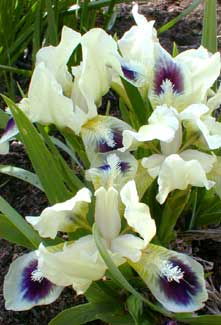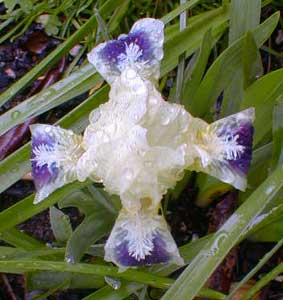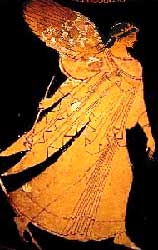
'Navy Doll'
Miniature Dwarf Bearded Iris
"Now spring has clad the grove in green,
And strew'd the lea wi' flowers."
-Robert Burns
(1759‚1796)
(1759‚1796)
 The falls of Iris pumila 'Navy Doll's' flowers are such a pale creamy yellow as to appear nearly ivory, with a dark purple-blue blotch on the beard.
The falls of Iris pumila 'Navy Doll's' flowers are such a pale creamy yellow as to appear nearly ivory, with a dark purple-blue blotch on the beard.The first photo shows the regular three-falled flowers, but the second photo shows from overhead a freak flower that has four falls neatly arranged in a perfect Maltese cross. Four-petalled irises occur rarely, but I'm not aware that it is a trait that can be built into them, for surely there'd be such strains if it were possible.
The variety was first introduced to gardeners in 1967. The name 'Navy Doll' alludes to the color of the blotch (Navy) & to the dwarf status of the iris (Doll). The height of 'Navy Doll' when in bloom in early & mid April is four to seven inches. The leaves may grow a bit taller after the blooms are finished.
The category "Miniature Dwarf Bearded" or "MDB" sounds redundant to anyone who has not gotten used to Iris terminology. It indicates all varieties of bearded irises that are the smallest of the small. Dwarf Beardeds per se can be a foot tall; Miniature Dwarfs are half the size.
The Miniature Dwarf Irises are also the earliest blooming of the rhizomitous irises. Though not nearly so early as the small bulbous reticulated irises, nevertheless 'Navy Doll' is in fat bud before the end of March & in full flower for April.
It wants full sun for a minimum of half the day. Irises are very drought-hardy, but won't bloom as well without somewhat regular waterings in extremely well draining soil. A raised garden or rockery ledge is perfect to insure perfect drainage, at the very front edges due to the small size of the plant.
Division & replanting is usually required in the third or fourth year, & is best done immediately after blooms have faded. Low-nitrogen fertilizer at winter's end, or about six weeks before blooming, is as much feeding as it requires.
 Irises are named for the Greek Messenger-goddess, sometimes likened Goddess of Rainbows, though this is misleading. Iris does mean "Rainbow" but is homonymous with "eiris," Messenger.
Irises are named for the Greek Messenger-goddess, sometimes likened Goddess of Rainbows, though this is misleading. Iris does mean "Rainbow" but is homonymous with "eiris," Messenger.Being a Rainbow-goddess may at first blush seem a bit nambypamby, but if one thinks of the importance of the rainbow even in Torah, as a convenant between God & Humanity, one immediately has a clue to the deep significance of this omen-invested bridge between the divine realm & the world. The Rainbow of scripture appears after the flooding of the world, & Iris was herself something of a Sea-goddess, being the daughter of the Oceanid Electra & the Sea-god Thaumas.
Her other epithets were Storm-Footed & Golden-Winged, & she was sometimes warlike in that she drove a chariot with four fierce steeds, who were the winds of the four directions. Quintus Smyrnaeus would have her be Zeus's personal charioteer, driving him into stormy battles. At Troy, Iris carried Aphrodite wounded from the battlefield & placed her in her own avenging chariot. Callimachus described Iris as Hera's warlike avenger, perched atop high cliffs at Mimas, threatening all cities that would give succor to Leto. According to the Argonatucia, her sisters were the Harpies whom she protected & over whom she had rule.
Her rainbow was the road by which she came & went from Olympus or Heaven, & she had easy access to the realm of the sea, & came & went at will from Tartarus. She brought messages back & forth between celestial & infernal gods, serving most frequently Hera & Aphrodite, but often displacing Hermes or together with Hermes serving as the divine messenger of all divinity.
Iris bore a caduceus akin to that of Hermes, & was usually shown as winged, or at least with winged heals. She elsetimes bore a pitcher of water by which the gods swore oaths, the water coming from the River Styx in Thanatos. She was the color of saffron derived from the sacred crocus of Crete, & indicative of violent sexuality, & symbolic of morning light as the awakening of wisdom. Some ancient authorities made her rather than Aphrodite the mother of Eros, & of another of the Erotes, Pothos.